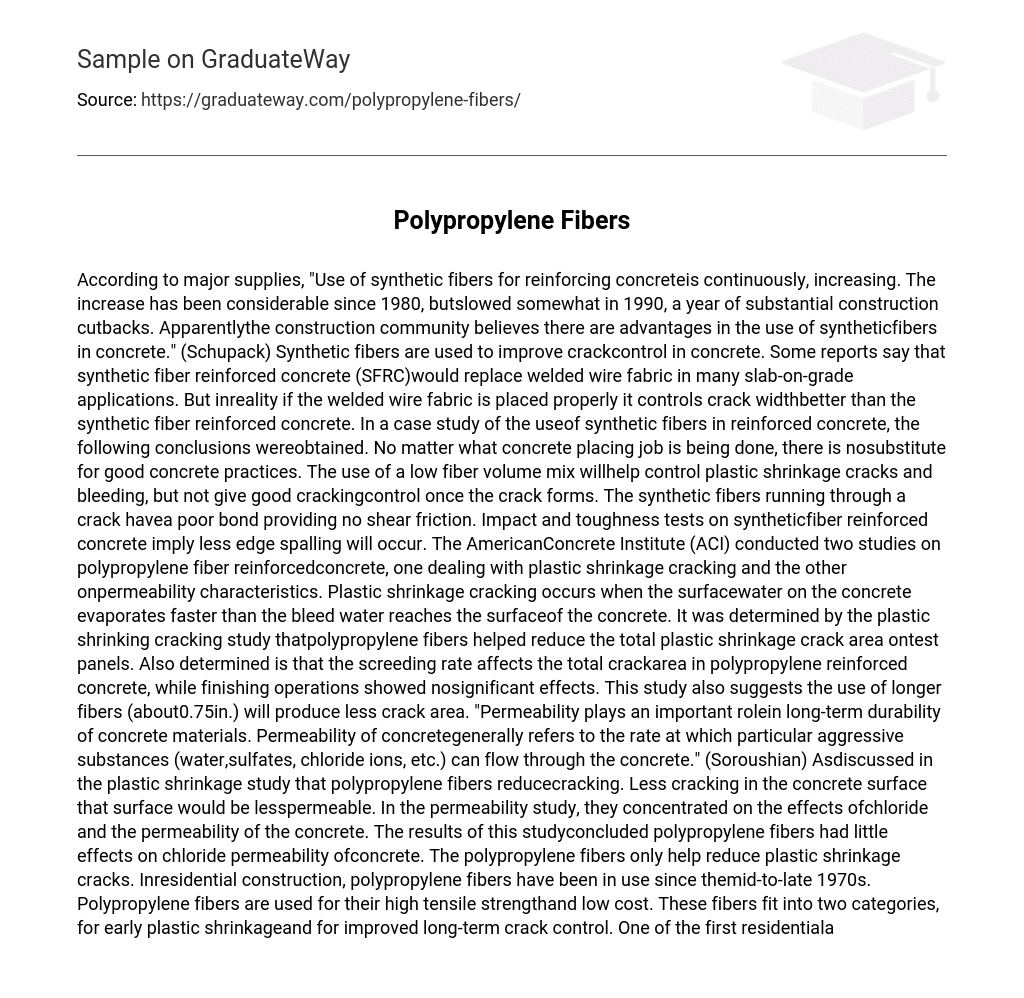According to major supplies, “Use of synthetic fibers for reinforcing concreteis continuously, increasing. The increase has been considerable since 1980, butslowed somewhat in 1990, a year of substantial construction cutbacks. Apparentlythe construction community believes there are advantages in the use of syntheticfibers in concrete.” (Schupack) Synthetic fibers are used to improve crackcontrol in concrete. Some reports say that synthetic fiber reinforced concrete (SFRC)would replace welded wire fabric in many slab-on-grade applications. But inreality if the welded wire fabric is placed properly it controls crack widthbetter than the synthetic fiber reinforced concrete. In a case study of the useof synthetic fibers in reinforced concrete, the following conclusions wereobtained. No matter what concrete placing job is being done, there is nosubstitute for good concrete practices. The use of a low fiber volume mix willhelp control plastic shrinkage cracks and bleeding, but not give good crackingcontrol once the crack forms. The synthetic fibers running through a crack havea poor bond providing no shear friction. Impact and toughness tests on syntheticfiber reinforced concrete imply less edge spalling will occur. The AmericanConcrete Institute (ACI) conducted two studies on polypropylene fiber reinforcedconcrete, one dealing with plastic shrinkage cracking and the other onpermeability characteristics. Plastic shrinkage cracking occurs when the surfacewater on the concrete evaporates faster than the bleed water reaches the surfaceof the concrete. It was determined by the plastic shrinking cracking study thatpolypropylene fibers helped reduce the total plastic shrinkage crack area ontest panels. Also determined is that the screeding rate affects the total crackarea in polypropylene reinforced concrete, while finishing operations showed nosignificant effects. This study also suggests the use of longer fibers (about0.75in.) will produce less crack area. “Permeability plays an important rolein long-term durability of concrete materials. Permeability of concretegenerally refers to the rate at which particular aggressive substances (water,sulfates, chloride ions, etc.) can flow through the concrete.” (Soroushian) Asdiscussed in the plastic shrinkage study that polypropylene fibers reducecracking. Less cracking in the concrete surface that surface would be lesspermeable. In the permeability study, they concentrated on the effects ofchloride and the permeability of the concrete. The results of this studyconcluded polypropylene fibers had little effects on chloride permeability ofconcrete. The polypropylene fibers only help reduce plastic shrinkage cracks. Inresidential construction, polypropylene fibers have been in use since themid-to-late 1970s. Polypropylene fibers are used for their high tensile strengthand low cost. These fibers fit into two categories, for early plastic shrinkageand for improved long-term crack control. One of the first residentialapplications of polypropylene fibers was in western Pennsylvania, in March of1979. Fibers were used in all the flat work of the residence. Polypropylenefibers have gained acceptance by residential home builders due to itsflexibility and its ability to conform to forms. Home builders say polypropylenefibers help them sell more concrete by reducing the potential risks of cracking.
The use of polypropylene does not compensate for the lack of good design,water/cement ratios, temperature and wind conditions. One important thing toremember is nothing replaces good concrete practices.
BibliographySchupack, Morris, and William R. Stanley. “Seven Case Studies of SyntheticFiber Reinforced Slabs.” Concrete International Feb. 1992:50-56. Soroushian,Parviz., Faiz Mirza, and Abdulraman Alhozaimy. “Permeability Characteristicsof Polypropylene Fiber Reinforced Concrete.” ACI Materials Journal92(1995):291-295. Mirza, Faiz., Parviz Soroushian, and Abdulraman Alhozaimy.
“Plastic Shrinkage Cracking of Polypropylene Fiber Reinforced Concrete.” ACIMaterials Journal 92(1995):553-560. Biddle, Daniel T. “Fiber Reinforcement inResidential Concrete.” Concrete International Feb. 1991:46-47.





